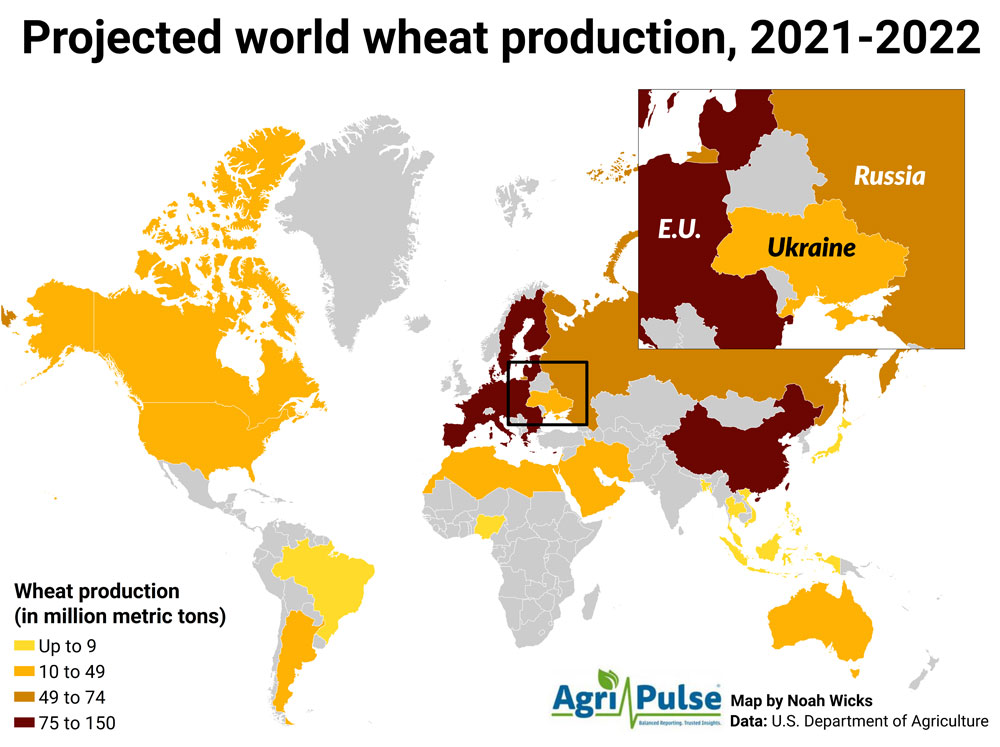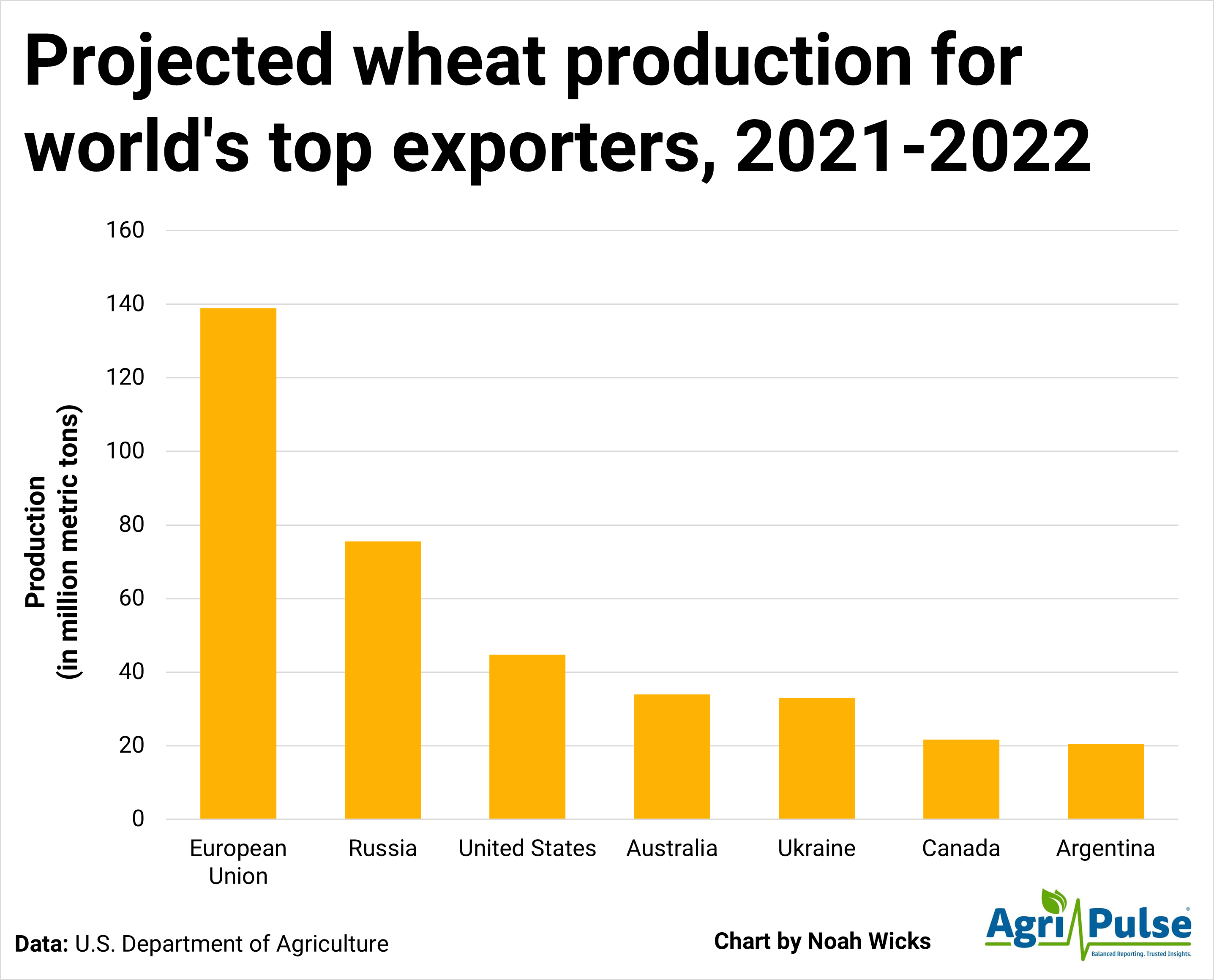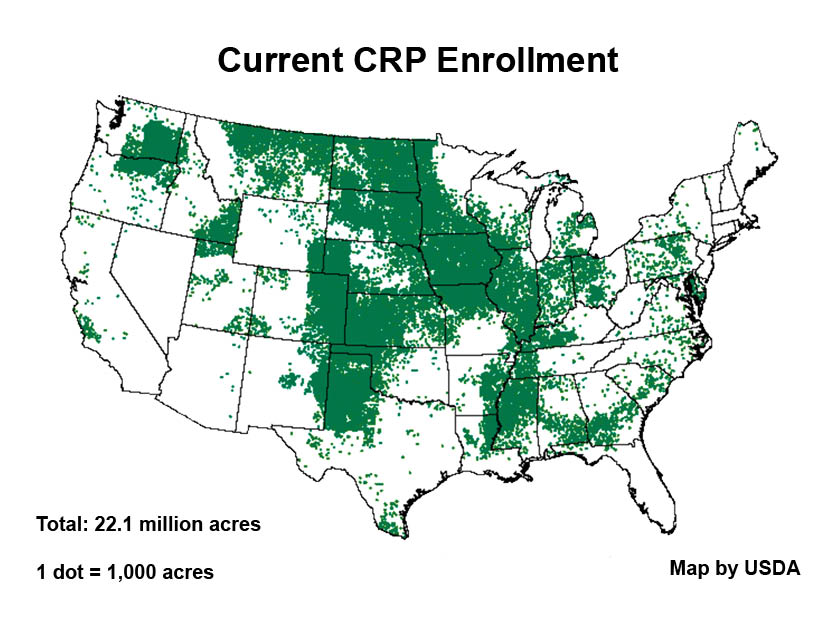The war in Ukraine is threatening to cut global grain supplies and worsen food insecurity, leading to proposals to ramp up agricultural production in the United States and Europe by planting crops this year on conservation acreage.
Ukraine is a major global supplier of wheat, corn and vegetable oil. It's unclear at this point how much of the country's winter wheat crop can be harvested and exported or how much of the nation's corn and sunflower crops can be planted this spring.
European farmers, who have consistently pushed back against some of the strictest restraints in the European Union's Farm to Fork and Biodiversity Strategy programs, are pressuring the European Commission — the EU's governmental arm — to allow cultivation of all available land this spring as farmers in Ukraine prepare to harvest wheat and struggle to ready fields for spring crops amid the growing violence that’s tearing the country apart.
“Since the Russian government is using food security as a weapon, we must counter it with a food shield,” says Christiane Lambert, president of the European farm and co-op organization Copa and Cogeca.
The latest data from the European Commission shows that there are roughly 5 million acres of idled farm land that could be planted in the EU.
Meanwhile, a leading agricultural economist in the United States last week proposed to open the 22-million-acre Conservation Reserve Program to emergency cropping this year. “I am convinced (the Ukraine crisis) is going to be the biggest supply shock to global grain markets in my lifetime," said Scott Irwin of the University of Illinois.
Commodity prices have risen sharply due to the crisis. Chicago wheat futures closed at $12.87 a bushel Tuesday, up from about $8 in mid-February. Corn futures are up about a dollar a bushel over that period to $7.55. Soybean futures are up from $15.74 since Feb. 14 to $16.90.

A spokesperson for USDA said there were no discussions about opening CRP, and it's not clear how much of the land farmers would be willing to plant, especially since much of the southern and central Plains is in the grip of a drought. But the top Republican on the Senate Agriculture Committee, John Boozman of Arkansas, said the idea should be on the table. "I think we very much need to look at that," Boozman told Agri-Pulse.
In a letter to Agriculture Secretary Tom Vilsack on Tuesday, Boozman stopped short of calling for cropping of CRP acres but did ask Vilsack to delay enrollment for new contracts.
In response to the Boozman letter, USDA said Tuesday "there has been no change in our position."
But Kip Tom, a former U.S. ambassador to the UN Food and Agriculture Organization and World Food Program during the Trump administration, said the impact of the crisis on poor countries "is going to get much worse than what most of us understand at this point in time."
He supports allowing farming of conservation acres on both sides of the Atlantic. "If there was ever a time we need to open up CRP in the United States, and Europe, it's now," he said. He added, "I would rather them do that than try to restrict ethanol production, biofuel production."
Ukraine has become a critical part of the global food supply in recent years. USDA's February forecast for global grain markets estimated Ukraine would produce 33 million metric tons of wheat for the 2021-2022 marketing year, only slightly less than Australia, with 24 million tons expected to be exported. Meanwhile, Ukraine was forecast to export 33.5 million of the 42 million metric tons of corn it produced in 2021.
Ukraine farmers have tripled their corn acreage over the past 15 years and yields have doubled, according to USDA's Economic Research Service. Ukraine is now one of the world's four major exporters of corn, “on par with Brazil and Argentina,” ERS says.
EU farm group: Time for 'paradigm shift'
EU Agriculture Commissioner Janusz Wojciechowski says that what little Ukraine can harvest will go towards feeding people still in the country and no exports are expected. That’s going to affect nearby countries like Estonia, Lithuania, Latvia and Poland the most. Those countries and others need grain and oilseeds to make bread and livestock feed.
“A paradigm shift is needed in the way Brussels thinks about agriculture, starting with the objectives set out in the Farm to Fork,” Copa and Cogeca said in a statement released Sunday.
The European Union is attempting through Farm to Fork to overhaul the way its 27 nations farm and produce food by cutting the use of pesticides on farms by 50%, reducing fertilizer usage by 20% and requiring that 25% of its farmland shift to organic.
While the proposal may be more sustainable, studies like one performed by USDA stress they will also slash European production.
European agricultural production would decline by as much as 4%, and food prices would rise by as much as 60% as a result of Farm to Fork and the Biodiversity Strategy, according to the ERS economists, who evaluated multiple scenarios.
 EU politicians, who have been preoccupied for years with making agriculture greener, need to also recognize, farmers say, that the situation in Ukraine means that EU farmers will have to produce more.
EU politicians, who have been preoccupied for years with making agriculture greener, need to also recognize, farmers say, that the situation in Ukraine means that EU farmers will have to produce more.
“We don’t have a problem with sustainability, but we underline the importance that we need to produce sufficient volumes to supply the market needs,” said Pekka Pesonen, secretary general of Copa and Cogeca, the EU farm organization.
At a minimum, European farmers need to be able to plant on all of the arable land that’s available and that means the 27 EU countries need to drop environmental restrictions that idle farmable land, the group said.
“Copa and Cogeca are asking to be able to cultivate all available land in 2022 to compensate for the blockage of Russian and Ukrainian production,” the group said. “Everything must be done to prevent disruptions in supply chains, which will inevitably lead to shortages in certain parts of the world. This is an essential question of food sovereignty and democratic stability.”
The European Commission formally adopted its next common agricultural policy, or CAP, in December. CAP, which is the equivalent of the U.S. farm bill, will require every farm to set aside at least 3% of arable land in order to qualify for subsidies.
Looking for the best, most comprehensive and balanced news source in agriculture? Our Agri-Pulse editors don't miss a beat! Sign up for a free month-long subscription.
The shortage of crops expected as a result of Russia’s war on Ukraine should take precedence over protection of the EU's 5 million acres of idled land, said Pesonen.
Copa and Cogeca Chief Policy Advisor Paulo Gouveia tells Agri-Pulse that “sustainability is and remains a key priority” for the EU’s farmers, but “the recent invasion of Ukraine by Russia has effectively changed the landscape. Productions costs that were already on the rise have seen steeper increases in the past few days while EU production will either stagnate or decrease.”
European farmers don’t want to rely even more on imports, so politicians are going to have to reassess Farm to Fork, he said
And it looks like politicians are listening.
“The terrible events taking place in Ukraine cast a tragic light on the need for us to strengthen our food sovereignty so as to ensure food security in times of crisis, both within the European Union and around the world,” French Agriculture Minister Julien Denormandie said during a Brussels press conference last week.
Denormandie, speaking after a meeting of Europe’s ag ministers, called directly for EU member countries to allow fallow land to be planted. He stressed that several ag ministers in the meeting last Wednesday “suggested we could use set-aside land” to grow more grains and oilseeds in order to feed livestock.
Wojciechowski promised that it’s an option under consideration, but he went even further. The EU’s ag ministers, he said, are beginning to discuss the Farm to Fork strategy in the context of the Ukrainian crisis.
“If food security is in danger, then we need to have another look at the objectives (of Farm to Fork) and possibly correct them,” Wojciechowski said. “I think we are in that situation now, which is why there’s a need for analysis.”
That comes close to what the EU’s farmers are saying, and Pesonen says there’s a very good reason for that. Ag ministers, he stressed, “know perfectly well that they will get the blame if we have shortages and consequently higher prices in the marketplace.”
Senate Democrat says CRP should be left alone
High prices are likely to fall hardest on the poor in developing countries who pay a larger share of their income for food. Countries in the Middle East and North Africa where wheat is a staple food will be among the hardest hit, economists say.
“You won't see a global food shortage. Unfortunately, what you're going to see is globally many many millions of people, even billions, might not be able to afford to buy the food, but the food will be available,” Sal Gilbertie, president of Teucrium Trading LLC, told Yahoo! Finance.
But the biggest hit to the global food supplies could be the effect of the crisis on fertilizer supplies, said James Thurlow, a development economist at the International Food Policy Research Institute. Fertilizer prices were skyrocketing even before the crisis, and the Russian government last week moved to suspend exports from its fertilizer manufacturers.
"What happens next season when the fertilizer is far more expensive and productivity begins to fall? I think that's when we're going to start worrying about broad-based impacts on the global food system," Thurlow said.
Irwin, the University of Illinois economist, believes there is a dire and immediate need for additional grain acreage this spring, and he argues that the Conservation Reserve Program is the only "policy lever" available to the Biden administration.

"The world desperately needs additional acres for grain production in 2022," Irwin wrote on his Twitter feed. "Basically nothing that can be done in the short run except to run up the price of grain high enough to ration demand. Market will work but could take wildly high price."
Texas has the most land in CRP, about 2.3 million acres, followed by Colorado with 2 million, South Dakota with 1.75 million and Kansas with 1.74 million.
Republican Sen. Kevin Cramer, whose home state of North Dakota has 1.2 million acres enrolled, also thinks CRP should be an option for cropping this year.
"Everyone should be deeply concerned about global food prices hitting record highs at the same time an agricultural powerhouse like Ukraine is mired in a struggle for its freedom. Directing USDA to examine whether Conservation Reserve Program acres should be opened for cropping to avoid a global food shortage is just one of several considerations for the Biden administration," he said in a statement to Agri-Pulse.
Opening CRP to cropping this year would almost certainly face strong opposition from environmental groups, and some Democrats told Agri-Pulse they don't think it's justified.
“Investing in the conservation programs that help producers prevent runoff is good for farmers, it’s good for taxpayers, and it’s good for our environment. Ohio farmers – whether they grow corn, soybeans, or wheat – respond to market dynamics and there’s no reason to roll back CRP and other critical conservation protections," Sen. Sherrod Brown, D-Ohio, said in a statement to Agri-Pulse.
Garrett Downs contributed to this report.
For more news, go to Agri-Pulse.com.



